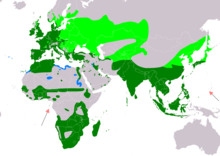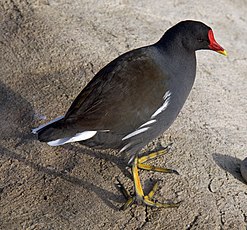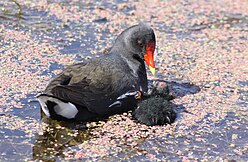Common moorhen
| Common moorhen | |
|---|---|

| |
| Adult G. c. chloropus and audio recording of call, both from France | |
| Scientific classification | |
| Domain: | Eukaryota |
| Kingdom: | Animalia |
| Phylum: | Chordata |
| Class: | Aves |
| Order: | Gruiformes |
| Family: | Rallidae |
| Genus: | Gallinula |
| Species: | G. chloropus
|
| Binomial name | |
| Gallinula chloropus | |
| Subspecies | |
|
About five; see text | |

| |
| Range of G. chloropus Breeding Resident Non-breeding Probably extinct
| |
| Synonyms | |
| |
The common moorhen (Gallinula chloropus), also known as the waterhen or swamp chicken, is a bird species in the rail family (Rallidae). It is distributed across many parts of the Old World, from Africa to Europe and Asia.[1]
The common moorhen lives around well-vegetated marshes, ponds, canals and other wetlands.
The closely related
Name
The name mor-hen has been recorded in English since the 13th century.[4] The word moor here is an old sense meaning marsh;[4] the species is not usually found in moorland. An older name, common waterhen, is more descriptive of the bird's habitat.
A "watercock" is not a male "waterhen" but the rail species
The
Description

The moorhen is a distinctive species, with predominantly black and brown plumage, with the exception of a white under-tail, white streaks on the flanks, yellow legs and a red frontal shield. The bill is red with a yellow tip. The young are browner and lack the red shield. The frontal shield of the adult has a rounded top and fairly parallel sides; the tailward margin of the red unfeathered area is a smooth waving line. In the related common gallinule (Gallinula galeata) of the Americas, the frontal shield has a fairly straight top and is less wide towards the bill, giving a marked indentation to the back margin of the red area.
The common moorhen gives a wide range of gargling calls and will emit loud hisses when threatened.[6] A midsized to large rail, it can range from 30 to 38 cm (12 to 15 in) in length and span 50 to 62 cm (20 to 24 in) across the wings. The body mass of this species can range from 192 to 500 g (6.8 to 17.6 oz).[7][8]
Habitat
This is a common breeding and resident bird in marsh environments, rivers, well-vegetated lakes and even in city parks. Populations in areas where the waters freeze, such as eastern Europe, will migrate to more temperate climates. In China, common moorhen populations are largely resident south of the Yangtze River, whilst northern populations migrate in the winter, therefore these populations show high genetic diversity.[9]
Behaviour
Diet and feeding
This species will consume a wide variety of vegetable material and small aquatic creatures. They forage beside or in the water, sometimes walking on lilypads or upending in the water to feed. They are often secretive, but can become tame in some areas. Despite loss of habitat in parts of its range, the common moorhen remains plentiful and widespread.
Breeding
The birds are territorial during breeding season, and will fight with other members of their species, as well as other water birds such as
Status and population
On a global scale – all subspecies taken together – the common moorhen is as abundant as its vernacular name implies. It is therefore considered a species of
Other localised groups of common moorhen are starting to come under threat. The Royal Society for the Protection of Birds in the United Kingdom has the common moorhen classified as one of its 103 species whose conservation status is of moderate concern[12] due to its recent population decine. The number of breeding pairs has fallen to its lowest level in the UK since 1966[13] and has been protected under the Wildlife and Countryside Act (1981).
The common moorhen is one of the birds (the other is the Eurasian coot, Fulica atra) from which the cyclocoelid flatworm parasite Cyclocoelum mutabile was first described.[14] The bird is also parasitised by the moorhen flea, Dasypsyllus gallinulae.[15]
Subspecies
Five
| List of subspecies by date of description | |||
|---|---|---|---|
| Common and trinomial names |
Description | Range | |
| Eurasian common moorhen G. c. chloropus (Linnaeus, 1758) Includes correiana and indica. |
 |
Wings and back blackish-olive | Ranges from Northwest Europe to North Cape Verde islands.
|
| Indo-Pacific common moorhen G. c. orientalis (Horsfield, 1821) |
Small, with slate grey upperwing coverts and large frontal shield. | Found in the Seychelles, Andaman Islands, and South Malaysia through Indonesia; also found in the Philippines and Palau. The breeding population existing on Yap in Micronesia since the 1980s is probably of this subspecies, but might be of the rare G. c. guami.[19][20] Population size: Perhaps a few 100s on Palau as of the early 2000s,[11] less than 100 on Yap as of the early 2000s.[19][20] | |
| African common moorhen G. c. meridionalis (C. L. Brehm, 1831) |
 |
Similar to orientalis, but the frontal shield is smaller. | Found in Sub-Saharan Africa and Saint Helena. |
| Madagascan common moorhen G. c. pyrrhorrhoa (A. Newton, 1861) |
 |
Similar to meridionalis, but the undertail coverts are buff. | Found on the islands of Madagascar, Réunion, Mauritius, and the Comoros. |
| Mariana common moorhen G. c. guami (Hartert, 1917) Called pulattat in Chamorro. |
Body plumage is very dark. | Endemic to the Northern Mariana Islands, but see also G. c. orientalis above. Population size: About 300 as of 2001.[21] | |
Life cycle
-
Collecting for nest, Wolvercote, Oxfordshire
-
On nest, Wolvercote, Oxfordshire
-
Chick, 1–2 weeks old
-
Moorhen feeding chick some regurgitated food
-
Juvenile,Strumpshaw Fen, Norfolk
-
Young adult, London
References
- ^ . Retrieved 12 November 2021.
- ^ "Common Moorhen (Gallinula chloropus) Linnaeus, 1758". Avibase. Retrieved 1 November 2013.
- S2CID 13691956.
- ^ ISBN 978-0-19-866196-2.
- ISBN 978-1-4081-2501-4.
- ^ ISBN 0-19-268579-1.
- ^ Common moorhen media from ARKive Retrieved 25 February 2013.
- ^ "Common Gallinule". All About Birds. Cornell Lab of Ornithology. Retrieved 25 February 2013.
- .
- ^ Mann, Clive F. (1991). "Sunda Frogmouth Batrachostomus cornutus carrying its young" (PDF). Forktail. 6: 77–78. Archived from the original (PDF) on 2016-03-04. Retrieved 2015-06-08.
- ^ a b VanderWerf, Eric A.; Wiles, Gary J.; Marshall, Ann P.; Knecht, Melia (2006). "Observations of migrants and other birds in Palau, April–May 2005, including the first Micronesian record of a Richard's Pipit". Micronesica. 39 (1): 11–29.
- ^ "Moorhen Bird Facts | Gallinula Chloropus". The RSPB. Retrieved 2022-06-17.
- ^ "Species | BTO - British Trust for Ornithology". app.bto.org. 16 July 2010. Retrieved 2022-06-17.
- .
- ^ Rothschild, Miriam; Clay, Theresa (1953). Fleas, Flukes and Cuckoos. A study of bird parasites. London: Collins. p. 113.
- JSTOR 4082892.
- JSTOR 1366727.
- .
- ^ a b Wiles, Gary J.; Worthington, David J.; Beck, Robert E. Jr.; Pratt, H. Douglas; Aguon, Celestino F.; Pyle, Robert L. (2000). "Noteworthy Bird Records for Micronesia, with a Summary of Raptor Sightings in the Mariana Islands, 1988–1999". Micronesica. 32 (2): 257–284.
- ^ a b Wiles, Gary J.; Johnson, Nathan C.; de Cruz, Justine B.; Dutson, Guy; Camacho, Vicente A.; Kepler, Angela Kay; Vice, Daniel S.; Garrett, Kimball L.; Kessler, Curt C.; Pratt, H. Douglas (2004). "New and Noteworthy Bird Records for Micronesia, 1986–2003". Micronesica. 37 (1): 69–96.
- S2CID 85833785.
External links
- (Common) Moorhen species text in The Atlas of Southern African Birds
- Explore Species: Eurasian Moorhen at eBird (Cornell Lab of Ornithology)
- Common Gallinule Species Account – Cornell Lab of Ornithology
- Common Moorhen Information - Gallinula chloropus - USGS Patuxent Bird Identification InfoCenter
- Madeira Birds – Moorhen breeding in Madeira Island
- Ageing and sexing (PDF; 5.7 MB) by Javier Blasco-Zumeta & Gerd-Michael Heinze
- BirdLife species factsheet for Gallinula chloropus
- Common moorhen photo gallery at VIREO (Drexel University)
- Audio recordings of Common moorhen on Xeno-canto.









